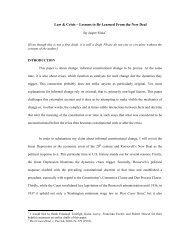updating brignoni-ponce - New York University School of Law
updating brignoni-ponce - New York University School of Law
updating brignoni-ponce - New York University School of Law
You also want an ePaper? Increase the reach of your titles
YUMPU automatically turns print PDFs into web optimized ePapers that Google loves.
618 LEGISLATION AND PUBLIC POLICY [Vol. 11:567<br />
fendants’ races, and the Court accepts that Detective McFadden was<br />
“unable to say precisely what first drew his eye to them” or why they<br />
“didn’t look quite right.” 321 The decision proceeds without any discussion<br />
<strong>of</strong> race, but it is clear in the trial transcript that McFadden’s<br />
suspicion was aroused because two black men were standing in front<br />
<strong>of</strong> a store during the middle <strong>of</strong> the day and because a white man<br />
stopped twice to chat with them. 322 Because the Court erased racial<br />
references from its decision and constructed a narrative <strong>of</strong> “police <strong>of</strong>ficer<br />
as expert,” the Court had no occasion to question the <strong>of</strong>ficer’s<br />
reliance on race and stereotypes. 323<br />
The problem with this facially race-neutral approach is that it<br />
avoids asking whether the decision to stop and question someone had<br />
a legitimate basis and simply assumes that the <strong>of</strong>ficer knows best. An<br />
alternative would be to recognize race as a relevant factor but to scrutinize<br />
the <strong>of</strong>ficer’s reliance on it. 324 One disadvantage <strong>of</strong> this approach<br />
lies in its reliance on judges—who typically are reluctant to<br />
find that <strong>of</strong>ficers engaged in racist behavior—to scrutinize the actions<br />
and motivations <strong>of</strong> law enforcement <strong>of</strong>ficers. 325 Additionally, the effectiveness<br />
<strong>of</strong> such scrutiny will vary per judge.<br />
Thus, the choice is between opting for a prohibition that signals<br />
that considering race is impermissible though allows <strong>of</strong>ficers to easily<br />
circumvent it by providing neutral explanations and opting for an opportunity<br />
for a judge to examine the permissible use <strong>of</strong> race. Neither<br />
option presents a sure path to curbing the harms that race-based immigration<br />
enforcement causes Latinos and other minority groups. However,<br />
given the reality that national origin is a necessary factor in<br />
immigration law enforcement and that past decisions have analyzed<br />
the use <strong>of</strong> a person’s apparent ancestry, 326 allowing race to be a factor<br />
in establishing a reasonable suspicion provides for critical review <strong>of</strong><br />
<strong>of</strong>ficers’ discretion to make a stop.<br />
mention <strong>of</strong> race, even though evidence had been presented that a black person fleeing<br />
the scene <strong>of</strong> a crime was more likely to be shot by police than a white one. Thompson,<br />
supra note 22, at 974–75. R<br />
321. See Thompson, supra note 22, at 966–67. R<br />
322. Id.<br />
323. Id. at 971 (internal quotations omitted) (“The ‘police <strong>of</strong>ficer as expert’ narrative<br />
allowed the Court in Terry to present a coherent, raceless narrative about why McFadden<br />
acted as he did.”).<br />
324. See id. at 1007.<br />
325. Id. at 1007–08; Kennedy, Suspect Policy, supra note 139, at 35. R<br />
326. See Part II.C (discussing United States v. Manzo-Jurado, 457 F.3d 928, 935<br />
(9th Cir. 2006); United States v. Montero-Camargo, 208 F.3d 1122, 1130 (9th Cir.<br />
2000); United States v. Chavez-Villarreal, 3 F.3d 124, 127 (5th Cir. 1993); and other<br />
cases that have scrutinized a Border Patrol <strong>of</strong>ficer’s reliance on racial appearance).
















